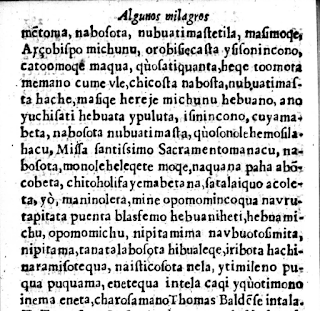My colleague and coauthor Timothy Johnson recently managed to discover a new Timucua book!
Here is a press release about it
https://www.flagler.edu/campus-community/news/flagler-professor-discovers-unknown-spanish-timucua-book-while-on-sabbatical.php?fbclid=IwAR31P56IhRyRKItBcFxToJaxtfpUcv7TsqeLdxXAK2Xi9c9lViSGIwgC0Yg
Here is a press release about it
https://www.flagler.edu/campus-community/news/flagler-professor-discovers-unknown-spanish-timucua-book-while-on-sabbatical.php?fbclid=IwAR31P56IhRyRKItBcFxToJaxtfpUcv7TsqeLdxXAK2Xi9c9lViSGIwgC0Yg
Some additional information:
- It is bound together with a copy of the 1627 Catechismo y Examen (Pareja, Francisco. 1627b. Cathecismo y Examen para los que comulgan. En lengua castellana y Timuquana. Mexico City: Imprenta de Iuan Ruyz.) There is another copy of this 1627 work in the British Museum, but the Codrington copy has the 1628 work bound after it.
- It does not duplicate any previously known book.
- The title calls it Part IIII, suggesting that Pareja, Francisco. 1627a.Catecismo en lengua timuquana y castellana en el qual se instruyen y cathequizan los adultos infieles que an de ser Christianos. Mexico City: Emprenta de Ioan Ruyz was probably intended to be parts 1 and 2. More on this:
- Pareja 1627 does have two parts -- the first part is an account of the creation of the world and the birth of Christ. The second part is an edited/corrected version of the 1612 book Pareja, Francisco. 1612a. Cathecismo en lengua castellana, y Timuquana. En el qual se contiene lo que se les puede enseñar a los adultos que an de ser baptizados. Mexico City: Impresa de la Viuda de Pedro Balli. (NY Historical Society)
- It is not clear what part III is. Is it the 1627 Catechismo y Examen? Nothing on the title page or introduction labels this as part III of a multi-part work.
Here is a link to the page at Codrington with the manuscript:















